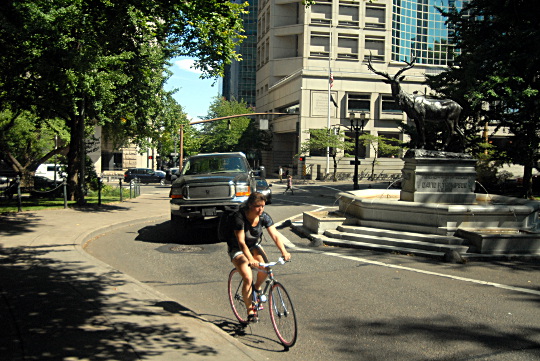
(Photos: M.Andersen/BikePortland)
As I write this, Portland police have just started a one-day enforcement of the city’s law against biking on downtown sidewalks north of Jefferson and south of Hoyt.
Here’s what a reader had to say about this on Facebook today:
Baldwin was giving voice to a big flaw in Portland’s campaign to prevent biking and walking conflicts downtown: when someone who’s not comfortable biking down the middle of a busy traffic lane needs to go downtown, where else are they supposed to ride except the sidewalk?
Fortunately for Baldwin (not to mention for downtown businesses trying to reduce their parking or transit costs and downtown car or truck drivers dealing with ever-rising congestion) a few recent developments downtown could open the door to some big bike improvements, if city leaders decide to take advantage of them.
About a tenth of downtown’s parking spaces just opened up
Last month, as part of what Commissioner Steve Novick described as part of his hunt for new transportation revenue, Portland stopped exempting people with general disability placards in their cars from unlimited free parking downtown. (People with special wheelchair-friendly vehicles can still park for free indefinitely.) The result, the city says, is that the cars have vanished from about 1,000 of downtown Portland’s 9,000 or so parking spaces.
“It’s open spaces,” city enforcement officer J.C. Udey told The Oregonian last month. “We have so much more parking.”
In an email yesterday to the Active Right of Way listserv, biking advocate Jessica Roberts wrote what many others have surely been thinking:
“Is there anything you’ve ever asked for downtown (cycle track or other), only to be told that we need the available parking spaces too badly to consider eliminating them? Surely now is your moment to speak up!”
A group of Old Town hospitality businesses is suggesting that the city convert auto parking or travel lanes to protected bike lanes.
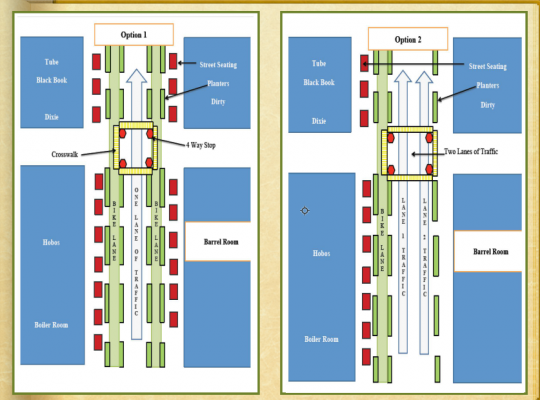
We reported two weeks ago that a coalition of 30 bars, restaurants and entertainment venues frustrated by the three-lane north-south speedways on 2nd and 3rd Avenues across Burnside have floated a plan to use planter-protected bike lanes to create what one business owner called “an awesome multi-use street” for safe driving, biking, walking and sitting in streetside cafes.
Advertisement
Voodoo Doughnut has started lobbying for a more human-friendly 3rd Avenue
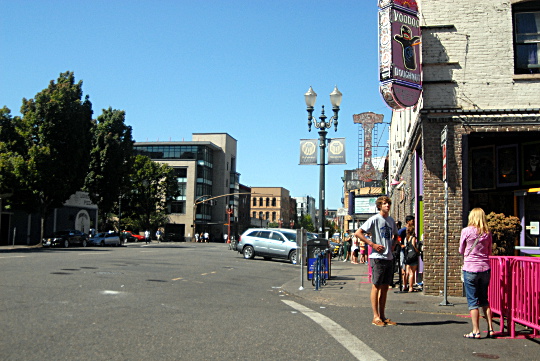
Here’s a intriguing email we got this week from Holly Policy at Voodoo Doughnut:
We are very interested in solutions that make SW 2nd and 3rd more friendly to pedestrians and bikes. Our long customer queue has made it a real challenge for Voodoo Doughnut on SW 3rd Ave to be a good neighbor to all the surrounding businesses. We have always tried to come up with creative solutions, and finally we decided to go to the city to get their take on things, and to find out exactly what we can and cannot do to improve the traffic and pedestrian flow around our business.
The City shared with us some ideas they already had for SW 3rd Ave, a continuation of the plan shown by the diagrams with your July 9 story, dictated by the end of the program which closes NW 2nd and 3rd to vehicle traffic on weekend nights. It is my understanding that the Ankeny Alley Association also has a few projects they would like to see addressed by PBOT. However, PBOT has made it clear that they have no money to spend on any unnecessary [note: maybe this means “nonessential”?] improvements. Any funding for improvements would have to come from grants or private investment.
The good news is that since I read your piece about plans for NW 2nd and 3rd Ave, I will work to forge a relationship between SW 3rd (Ankeny Alley Assoc, Voodoo) and NW 3rd (Dan Lenzen and Howard Weiner). Hopefully together we can meet some of our shared goals.
We’ll definitely be following this conversation as it develops.
The city already has funding to vastly improve bicycle access downtown.
We’ve written several times about the fact that a council-approved set of federal grants to improve biking and walking citywide included $6.6 million for “central-city multimodal safety improvements,” which we’ve been hearing for more than a year are likely to include north/south protected bike lanes and/or biking and walking improvements at the bridges across the river and I-405.
Though the city is currently “all quiet” on this work, the construction money arrives from Metro in 2016 and planning could begin next year.
“We asked for some advance funds — we could start working on it, but we haven’t even started the planning,” city spokeswoman Diane Dulken said Thursday. “We’re looking forward to getting started sometime in 2015 or 2016.”
Dulken said the principal of the project is to improve active transportation downtown, but the details — north-south protected bikeways? — remain hazy.
“The north-south is something we’ve talked about, but all options are on the table right now,” Dulken said. As we reported back in January 2013, this funded project is a golden opportunity to make much-needed improvements to bike access downtown.
While all these developments show promise for significant changes ahead, they still require leadership from local leaders. Without a champion within PBOT and City Hall — or anywhere else for that matter — these opportunities just might pass us by.
Correction 8/1: An earlier version of this post slightly misquoted Dulken. The city has asked for advance funds for its downtown bike lane project.




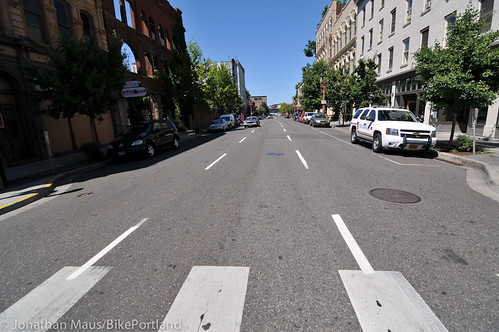

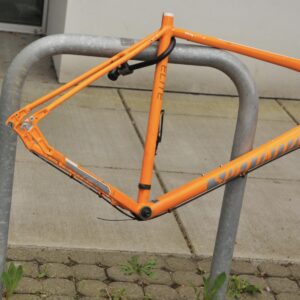
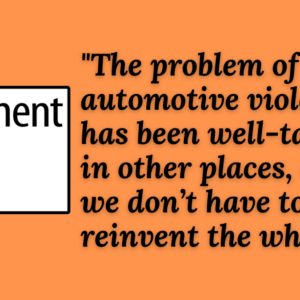
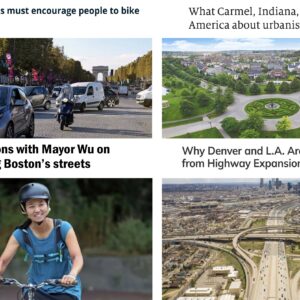
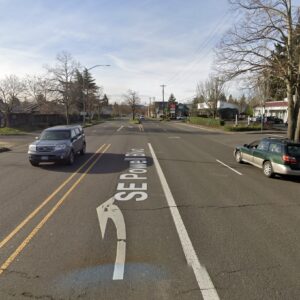
Thanks for reading.
BikePortland has served this community with independent community journalism since 2005. We rely on subscriptions from readers like you to survive. Your financial support is vital in keeping this valuable resource alive and well.
Please subscribe today to strengthen and expand our work.
Re: the top photo caption (“The Hawthorne Bridge is a fine place to ride a bike. The downtown street it leads to is not.”)
And I haven’t heard of any serious proposals to improve that. Both the lane configuration and the pavement quality on Main Street – where the extremely bike-busy Hawthorne dumps you downtown – absolutely stink for bikes. Fortunately I turn right on 2nd almost every morning, headed for the MAX Blue Line, which avoids most of the mess, but it definitely could use improvement.
Michael, did the 1,000 spaces opening up number come from PBOT? Did they do a before-and-after survey, or are they guessing? I wouldn’t be surprised, but that number is suspiciously round.
In fall 2011, the city counted exactly 1,007 of the placards in use, according to the Oregonian story. That’s also the number Dulken gave me today, out of 9,000 or so downtown street parking spaces.
A similar census will be done this September or October, she said.
Ah, got it. I doubt that number has gone to zero, but I’ll bet the new survey will show a dramatic drop. Remove the financial incentive to cheat, and voila, people stop cheating!
One thing is going to make it a little worse for about a year or more: the Sky 3 project, on Jefferson between SW 11th & 12th has just begun. There is now a fence up. It will block the bike lane and the outside motor vehicle lane during working hours. First they have to demolish the old Mural Room building, then they’re building a 15-story apartment building.
New housing going up in the central city is something to celebrate. I just wish Portland would make it much harder to contractors to block the right-of-way, especially sidewalks. In other cities contractors have to build pedestrian tunnels out of plywood.
I agree (with everything you wrote including) that new housing downtown is something to celebrate, but unfortunately this building is going to be high-end apartments (rentals) not the middle-income units that downtown needs. For anyone interested, the building is nearly 200 units and will have 1 parking space per 2 units. (Reportedly, the city wanted less than that.)
Pedestrian tunnel? Not in this case, as almost the entire sidewalk along that full block off Jefferson is going to be part of the demolition & excavation. I think we’ll be lucky if there is a bike lane detour. More likely, people on bikes will be merged into the one remaining lane.
I’m not connected to this project but I live in the area and have been following the progress closely.
Anybody heard anything new about the idea of making the Park Blocks car free?
New housing is almost always relatively expensive, because it is shiny and new and therefore desireable. But it drives down prices for other housing by sucking up demand from people who would otherwise live elsewhere. There is relatively cheap housing downtown; it’s in old buildings that were probably “luxury” in their day when they were new.
“But it drives down prices for other housing by sucking up demand from people who would otherwise live elsewhere.”
Has this actually been true? I feel like we’ve talked about that on here and many have said that that hasn’t really been the case. I would agree that it might be slowing increased prices.
It’s likely slowing the increase slightly, but I’d argue that the general uptick in rental prices from the new units on the market are cancelling out most of the downward pressure on the rents for older units.
This is my read, too. If this is true the only way this would not be a net good thing for preserving central-city affordability would be if the new homes were replacing currently operating old cheap housing stock on a 1/1 basis. Which isn’t what’s happening.
We’ve had this conversation before. New luxury (i.e. expensive) condo/apartment units may increase the supply of housing stock, but they don’t provide downward pressure on rents unless you’re looking at the market as a whole (metro Portland). For instance: there was essentially no housing stock in South Waterfront… they added a ton of stock there… did rents increase or decrease in South Waterfront as housing stock increased? There are now more than 2000 units (with more on the way!), so you’d think as more units came online the rents would fall, right?
“Building more apartments lowers rents” is a simplistic analysis that is encouraged by the people who are trying to do the building
“…I ended up on streets with no bike lane, no gutter, and rush hour traffic that kept forcing me off the road.”
I worked downtown for 8 years and commuted in rush hour traffic every day. Traffic lights in downtown Portland are timed at about 12.5 mph, if you find yourself on a downtown street by far the safest way to operate is just like a car, with your bike in the middle of the lane. Traffic can’t move any more quickly than your riding speed, so you’re not going to tick off drivers and so long as you act predictably (don’t weave in and out of the lane or try to split the lane) you’re not going to catch anyone by surprise.
It’s not the fastest way home, but I commuted downtown daily and never had a problem.
To expand on Alex Reed’s point, there was a huge boom in apartment buildings following the 1905 Lewis and Clark Centennial Exposition. These are the beautiful brick apartments through NW. I don’t have the data to support this, but I suspect they were charging a premium when they opened. Today they generally rent at below average prices for the neighborhood.
As regards construction blocking the right of way – there is a legitimate life safety concern for closing the sidewalk during demolition and excavation. However, once the building is out of the ground there’s really no reason other than convenience to block pedestrian access. But there’s a general contractor has no incentive to make access better until city code requires it.
So we just need to wait another 110 years? 🙂
While new buildings do become tomorrow’s lower-rent buildings this is a slow process. The more immediate solution to discriminatory and crypto-racist housing inequity in Portland is to fight for inclusionary zoning and rent control. In the context of generations of inequality and political corruption a so-called free market for housing is atavistic and punitive.
Comparatively, San Francisco has inclusionary zoning, rent control, strong tenant protections, but still has outrageously high rental prices. Most people agree this results from high demand from a booming tech sector combined with utterly absurd restrictions on building more housing (all over the peninsula), which doesn’t let supply keep up with that demand.
Rent control and inclusionary zoning are both prohibited by state statute.
Yes, Oregon could not implement the commenter’s solutions without a change to the law. My point is that even if it could, these programs in SF have had little effect (IZ) or a reverse-effect (rent control) on rental prices overall. They are a bonanza only if you are one of the lucky lottery winners who get a subsidized unit.
I live on the edge of Downtown, and am constantly frustrating by how poor the conditions for cycling are in Downtown and the Pearl compared with the rest of the city. This is the densest part of the entire state, and I believe there’s a lot of latent demand for better cycling conditions. This is a list of projects I’ve heard mentioned over the years make biking so much better, and which don’t seem like they’d be impossible:
1) Fix the Naito gap under the Steel bridge.
2) Extend the bike lanes on Naito at least as far as Harrison. This would make it a lot easier to get to South Waterfront, while avoiding the chaos that is Waterfront Park in the summer.
3) Bikelanes on Burnside between the bridge and the Park Blocks. It would mean losing parking, but that’s hardly a thriving retail corridor at the moment anyway.
4) Cycletrack on the Park Blocks, with a signalized crossing of Burnside and other major streets. When the Post Office site gets redeveloped, there’s probably a way to connect this to the Broadway Bridge. Again, this would likely require reducing parking, but do we really need parking on *both* side of SW 9th / Park and NW Park / 8th?
5) Protected bike lane on SW Columbia between Collins Circle and the Waterfront, to form a couplet with an improved SW Jefferson. Given that SW Clay / Market is the major east-west couplet for cars in that part of downtown, it would make to improve sense to improve these parallel streets for bikes.
6) Assuming the Westside Burnside-Couch couplet is dead, make NW Couch into a Bike Blvd from the Waterfront to NW 18th/19th. NW Couch really only functions as local access for cars, so I think some diverters could make it into a quiet street for biking.
7) And the same for NW Flanders between I-405 and the Steel Bridge. Longer term a crossing of the freeway would be great too.
8) Bikeshare. Safety in numbers, right?
For #2, I’d love for some protected bike lanes on Naito. Right now, it’s a choice between a speedway and congestion on the waterfront.
#4, I always feel uneasy bikkng down SW park because there’s no way to avoid the door zone due to the car parking on both sides. As I learned yesterday, the sidewalk down the middle of the Park Blocks is illegal to bike on. Why not close one direction of SW Park and make it a two-way bike street, then make the other side two-way for people driving? It’s a much better and safer use of space than the parking lot it is today.
do dutch and danish traffic planners build fully-separated bike lanes in dense urban areas where vehicle speeds are ~15 mph?
for the most part, no.
i believe the obvious solution to central portland’s car-centrism is to create car free or car-light routes. unfortunately it’s exceedingly rare to see planners (or their fans) advocate for this kind of cheap and effective allocation of space for active transport. the fact that planner and traffic wonk paychecks depend on design and implementation of over-engineered infrastructure might have something to do with this.
I’ve been to both Amsterdam and Copenhagen, and they certainly do have separated bike infrastructure in their central city. A lot of it. They might not build a lot on the secondary streets, but the street patterns of those older cities doesn’t really compare with Portland’s grid. In downtown there’s no real hierarchy of major and minor streets like there is in most European cities.
i was responding to the suggestion of adding a cycling track to the park blocks.
why not simply make the park blocks car free (or accessible to delivery vehicles in the early am or late pm only). and since you’ve visited AMS and CPH you should know exactly what I’m talking about.
I know that not everyone will ever feel comfortable mixing it up with cars downtown, but Portland is hands down the most downtown bike accommodating city in the country. I’ve bike downtown in a lot of cities in the US, and cars in Portland are on average far more aware, considerate, and “okay” with bikes than just about any other major city in the US. Slow light timing certainly helps in this regard (when going downhill even most “slower” cyclists can keep up with car traffic.
I understand this is probably not going to get a ton more cyclists out there, but I think that people new to the area are usually pleasantly surprised that biking amongst the cars downtown usually isn’t that bad.
As for the cycle track on the Park blocks, there has been some talk about this before. While I also want cycle tracks on major streets downtown, the Green Loop would be fairly cheap to get going, and may prove safer for all-ages.
http://bikeportland.org/2014/01/17/citys-green-loop-could-be-like-sunday-parkways-everyday-100088
http://greenbikeloop.weebly.com/#/
Similar to the comment above, it would also be effected by construction. It could not be considered until the construction adjacent to Director’s park is done.
places that do not need cycletracks:
SE salmon street, NE Going, the SW/NW park blocks
places that do need cycletracks:
Sandy
Powell
Barbur
82nd
122nd
Chavez
Naito
Foster
MLK/Grand
Division
Burnside & couplet
Broadway/Wiedler
Just to expand on this EXCELLENT list of suggestions:
1) Give NW Broadway a road diet to one lane in each direction, in order to finally install a northbound bike lane from Burnside to the bridge.
2) Fill the bike lane gap on NW 16th in the area of Glisan/Everett/I-405 ramps
3) NW Glisan and Everett buffered bike lanes all the way to Naito
4) Left-side northbound cycle track on 4th from I-405 to NW Glisan
5) Aggressive signal installation to reduce speeding. NW Everett and Glisan have funding to get a signal at 13th at some point, but they need lights at the Park Blocks. SW 3rd/4th at Ash Street needs signals, as does Burnside at the Park Blocks.
A cycle track on the Park Blocks wouldn’t likely be feasible or of any great benefit. Flaneur’s comment down below, raises questions about this:
http://bikeportland.org/2014/07/31/dont-despair-theres-hope-better-bike-access-downtown-109658#comment-5284362
Depends some on what people consider that a cycle track should be. It’s never seemed to me that people visiting the Park Blocks, or using the streets bordering them, were imposed upon unreasonably by cars being able to use those streets.
The parking allowed on both sides of the streets, on the other hand, seriously adds to congestion and and hazards to people on foot and biking. By sacrificing a bit of parking revenue, limiting parking to just the curbs opposite the park, and the city could vastly improve the functionality of the park’s border streets for walking and biking. Those streets used to be that way before some bean counters with the city decided they knew better.
Sharrow markings cost about $250 each. How about marking each lane in portland with a sharrow every other block, even the streets with bike lanes? Take the Lane!
+1000
Sharrows are easily ignored. Separated infrastructure or traffic calming is not east to ignore.
Coming off the Hawthorne Bridge is just… beyond awful in regards to biking experience. After visiting Vancouver BC and riding on their cycle tracks that criss-cross downtown, Portland is getting farther and farther behind. 🙁
Bring back fareless square with some park ‘n rides.
That works for people who feel comfortable “taking the lane”, but for the inexperienced bicyclist, it’s likely to be a non-option and either put them on the sidewalk (potential ticket & pissed off pedestrians) or put them off riding (downtown) altogether. Definitely does nothing to entice the set of people who are “interested but concerned” — and those are the ones so desperately needed in Portland to get another bump in bicycling mode share.
the willingness of some cycling advocates to promote and exaggerate the dangers of cycling to support infrastructure ideology is, imo, akin to eating your own.
I don’t think I understand what’s being proposed by those advocating a North-South ‘cycletrack’ in the South Park Blocks. With no traffic signals and with cross-streets every 200 feet (including a number of heavily-trafficked streets that provide access to Highway 26, I-5, and I-405), how exactly would this work?